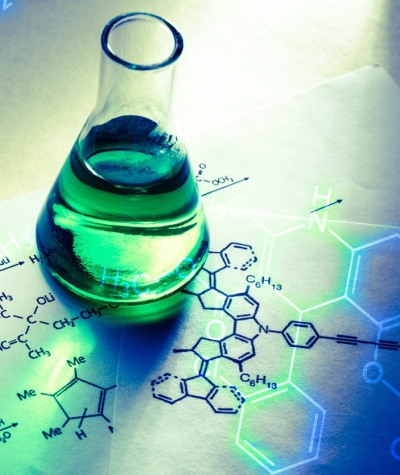Green chemistry is a set of principles and guidelines that encourage chemists to design more efficient chemical processes, producing more of the chemical they want with less unwanted by-products. Most cosmetic ingredients are made using chemical processes to transform chemicals, including natural ingredients, into something more useful and safe when applied to the human body. The principles of green chemistry aim to ensure that chemists use less energy, less water and solvents, and fewer process steps (a smaller series of reactions).
We should note that green chemistry does not mean "no chemistry". Modern chemistry is essential for our modern lifestyle and all of the products we take for granted, from cars to consumer electronics and from clothing to cosmetics. However, green chemistry uses modern and innovative techniques so that chemistry is more efficient and less damaging to the environment.
For more information on green chemistry and its use in the making of cosmetic products you can visit the University of York Green Chemistry Centre of Excellence website to learn more.
The commonly accepted Twelve Principles of Green Chemistry* are:
-
Prevent waste: Design chemical syntheses to prevent waste, leaving no waste to treat or clean up.
-
Design safer chemicals and products: Design chemical products to be fully effective, yet have little or no toxicity.
-
Design less hazardous chemical syntheses: Design syntheses to use and generate substances with little or no toxicity to humans and the environment.
-
Use renewable feedstocks: Use raw materials and feedstocks that are renewable rather than depleting. Renewable feedstocks are often made from agricultural products or are the wastes of other processes; depleting feedstocks are made from fossil fuels (petroleum, natural gas, or coal) or are mined.
-
Use catalysts, not stoichiometric reagents: Minimize waste by using catalytic reactions. Catalysts are used in small amounts and can carry out a single reaction many times. They are preferable to stoichiometric reagents, which are used in excess and work only once.
-
Avoid chemical derivatives: Avoid using blocking or protecting groups or any temporary modifications if possible. Derivatives use additional reagents and generate waste.
-
Maximize atom economy: Design syntheses so that the final product contains the maximum proportion of the starting materials. There should be few, if any, wasted atoms.
-
Use safer solvents and reaction conditions: Avoid using solvents, separation agents, or other auxiliary chemicals. If these chemicals are necessary, use innocuous chemicals.
-
Increase energy efficiency: Run chemical reactions at ambient temperature and pressure whenever possible.
-
Design chemicals and products to degrade after use: Design chemical products to break down to innocuous substances after use so that they do not accumulate in the environment.
-
Analyze in real time to prevent pollution: Include in-process real-time monitoring and control during syntheses to minimize or eliminate the formation of by-products.
-
Minimize the potential for accidents: Design chemicals and their forms (solid, liquid, or gas) to minimize the potential for chemical accidents including explosions, fires, and releases to the environment.
*Originally published by Paul Anastas and John Warner in Green Chemistry: Theory and Practice. (Oxford University Press: New York, 1998).

